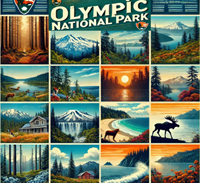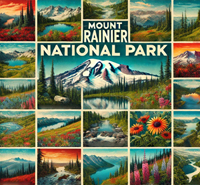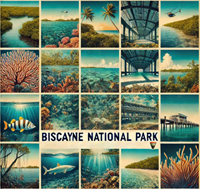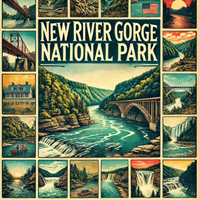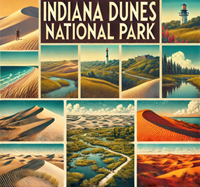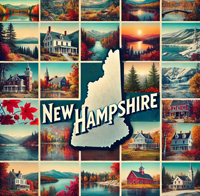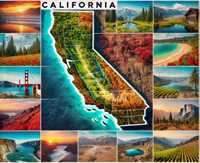
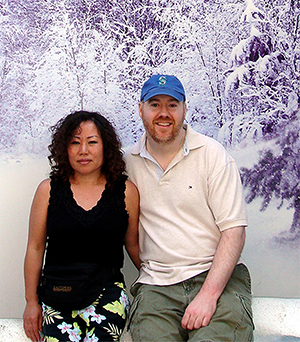
Embark on a journey curated by seasoned explorers William and Hui Cha Stanek, who have spent decades immersing themselves in the diverse landscapes of North America. These itineraries are more than just travel plans - they are thoughtfully crafted adventures designed to help you connect with the natural world, discover hidden gems, and create lasting memories.
National Parks Index | US Itineraries Index | American Roadtrips Index

Bring home a Bugville Critters book and watch as your child's love for reading and learning grows with every page. Hand-painted illustrations bring the heartwarming stories to life. Ask your librarian to add Bugville Critters to the library's digital collection today!
Discover William Stanek's Exclusive Art Collection
Explore and purchase the stunning art featured on this site. Own a piece of William Stanek's unique and captivating artwork today!
(May 2, 2025) 2 Days Exploring Bryce Canyon and Zion National Parks
Introduction: A Journey Through Nature's Sculpted Masterpieces
Personal Story: William's Unforgettable Morning at Bryce Canyon
One chilly autumn morning, before the world was fully awake, Hui Cha and I found ourselves at the rim of Bryce Canyon, wrapped in the stillness that only a place like this can offer. It was one of those mornings where the air was so crisp it felt like it could shatter. The stars above began to fade as the first hints of dawn lightened the sky. We stood there, sipping hot coffee from a thermos, watching the darkness slowly give way to a breathtaking array of colors. The hoodoos – those surreal, spire-like rock formations – began to emerge from the shadows, bathed in the soft, golden glow of the rising sun.
I had visited Bryce Canyon before, but this time felt different. Maybe it was the silence of the early morning, or perhaps it was the way the light seemed to dance across the landscape, bringing the hoodoos to life. As I set up my camera on the tripod, I couldn't help but feel a deep connection to this place – a connection that went beyond the beauty of the scenery. It was a moment of pure tranquility, where the world felt both vast and intimate, timeless yet fleeting. Hui Cha and I shared a look, knowing that this was a moment we would carry with us long after we had left the park.
About Bryce Canyon National Park
Bryce Canyon National Park, located in southern Utah, is renowned for its unique geological structures known as hoodoos. These towering spires of rock have been sculpted over millions of years through the forces of erosion, creating a landscape that feels otherworldly. Established as a national park in 1928, Bryce Canyon offers a blend of natural beauty and geological wonder that captivates every visitor who steps into its bounds.
About Zion National Park
Zion National Park, also located in southwestern Utah, is renowned for its stunning red rock formations, towering sandstone cliffs, and diverse ecosystems. Established in 1919, Zion spans over 146,000 acres and features some of the most dramatic scenery in the United States. The park is known for its iconic hikes, such as Angels Landing and The Narrows, which offer breathtaking views and unique experiences. Zion's deep canyons, lush valleys, and high plateaus create a vibrant and varied landscape that supports a rich array of wildlife. Visitors to Zion National Park can explore its natural beauty through numerous trails, scenic drives, and outdoor activities, making it a premier destination for nature lovers and adventure seekers alike.
Day 1:
Photography Tips: Capturing the Hoodoos at Sunrise
Morning: Sunrise at Sunrise Point
6:00 AM - Arrive at Sunrise Point
Overview: Begin your day with the iconic sunrise at Sunrise Point, one of the most popular and accessible spots in Bryce Canyon. The panoramic view from this vantage point offers an unparalleled perspective of the amphitheater, where the hoodoos glow in the soft light of dawn.
Tips from William: "Set up your tripod before the first light breaks. Use a wide-angle lens to capture the vastness of the amphitheater. As the sun rises, switch to a telephoto lens to zoom in on the details of the hoodoos – this is when their colors are most vibrant."
Insights from Hui Cha: "Dress warmly – mornings here can be quite cold, especially at higher elevations. A thermos of coffee or tea is essential, not just for warmth but to savor the quiet moment as the day begins."
How to Access Sunrise Point
Location: Sunrise Point is located along the rim of Bryce Canyon, near the Bryce Canyon Lodge. It's easily accessible by car, with parking available nearby.
Directions: From the Bryce Canyon Visitor Center, drive along the park road towards Bryce Canyon Lodge. Sunrise Point is clearly marked, with a short walk from the parking area to the viewpoint.
Trail Details: The walk to Sunrise Point is easy and short, less than a quarter mile on a well-maintained path. The elevation is moderate, but the trail can be a bit chilly in the early morning, so dress accordingly.
Photography Techniques:
-
Wide-Angle Magic: Start with a wide-angle lens (16-35mm) to capture the entire amphitheater. This allows you to frame the sunrise as it spreads across the landscape, highlighting the hoodoos' shadows and contours.
-
Telephoto Precision: As the sun rises, switch to a telephoto lens (70-200mm) to isolate individual hoodoos. Look for opportunities to capture the interplay of light and shadow on the spires.
-
Use of Filters: A graduated neutral density (ND) filter can help balance the exposure between the bright sky and the darker foreground, allowing you to capture the scene as you see it.
Mid-Morning: Navajo Loop Trail and Queens Garden Trail
8:00 AM - Begin Hike
Overview: After enjoying the sunrise, continue your adventure by exploring the Navajo Loop and Queens Garden Trails. This combination offers some of the best close-up views of Bryce Canyon's unique formations.
Tips from William: "This trail can be challenging, especially on the descent into the canyon. If you're not up for the entire loop, consider just doing the Queens Garden section – it's less strenuous but still offers incredible views."
Insights from Hui Cha: "Take your time on this hike. The best photos often come when you least expect them, so pause frequently to look around and appreciate the changing perspectives."
How to Access the Trail
Location: The trailhead for Navajo Loop is located near Sunset Point, which is a short drive or shuttle ride from Sunrise Point.
Directions: From Sunrise Point, drive or take the shuttle to Sunset Point. The trailhead is well-marked and begins at the rim.
Trail Details: The full loop is about 3 miles long, with a moderate difficulty level. The initial descent into the canyon can be steep, and the climb back out can be challenging. If you prefer an easier hike, consider the Queens Garden Trail alone, which is about 1.8 miles round trip and descends gradually into the amphitheater.
Photography Techniques:
-
Framing the Hoodoos: As you descend, use the natural curves of the trail to frame the hoodoos. This creates a sense of depth and scale in your photos.
-
Mid-Morning Light: The light during mid-morning is softer and less harsh, perfect for capturing the warm tones of the rocks. Use a polarizing filter to reduce glare and enhance the colors of the sky and rocks.
-
Details and Close-Ups: Switch to a macro lens or zoom in on the intricate textures of the rocks and the twisted shapes of the ancient trees that dot the landscape.
Afternoon: Scenic Drive and Inspiration Point
12:00 PM - Scenic Drive
Overview: After a morning of hiking, take a leisurely drive along the main park road, stopping at various viewpoints such as Bryce Point and Inspiration Point. These overlooks provide expansive views of the canyon and are perfect for midday photography.
Tips from William: "Midday light can be harsh, so look for areas where the hoodoos create their own shadows. This contrast can make for striking black-and-white photos."
Insights from Hui Cha: "Use this time to relax and absorb the vastness of Bryce Canyon. Pack a lunch and take it slow – there's no need to rush through these beautiful spots."
How to Access the Viewpoints
Location: The scenic drive is a straightforward route along the main park road, with clear signs leading to each viewpoint.
Directions: From Sunset Point, follow the park road south. Each viewpoint is well-marked, with parking areas and short trails leading to the best views.
Viewpoint Details: Inspiration Point is particularly known for its sweeping views of the amphitheater, while Bryce Point offers one of the highest overlooks in the park.
Photography Techniques:
-
Panoramic Shots: Use the panorama function on your camera or smartphone to capture the full scope of the amphitheater from Inspiration Point.
-
High-Contrast Scenes: Experiment with black-and-white photography to highlight the contrast between light and shadow on the rock formations.
-
Layered Compositions: Use the layers of hoodoos in the foreground and background to create depth in your photos.
Evening: Sunset at Sunset Point
5:00 PM - Sunset Viewing
Overview: Conclude your day at Sunset Point, where the golden hour transforms the canyon into a palette of warm colors. The hoodoos glow as the sun dips below the horizon, creating a serene and breathtaking experience.
Tips from William: "Arrive early to secure a good spot. As the sun sets, switch between wide-angle and telephoto lenses to capture both the grandeur and the details of the scene."
Insights from Hui Cha: "Bring a blanket or camp chair and take in the full sunset experience. This is the perfect time to reflect on the day and enjoy the beauty of Bryce Canyon."
How to Access Sunset Point
Location: Sunset Point is located near the Bryce Canyon Lodge, easily accessible from the main park road.
Directions: From any of the earlier viewpoints, drive or shuttle to Sunset Point. Parking can fill up quickly, so plan to arrive at least 30 minutes before sunset.
Viewpoint Details: Sunset Point offers a slightly different perspective of the amphitheater than Sunrise Point, with a focus on the area known as Silent City.
Photography Techniques:
-
Golden Hour Magic: Use a tripod to keep your shots steady as the light fades. The warm tones of the rocks are at their peak during this time, so make sure to capture a variety of angles.
-
Silhouettes: As the sun sets, experiment with silhouettes of the hoodoos against the colorful sky.
-
Long Exposures: After the sun has set, try longer exposures to capture the twilight and any lingering colors in the sky.
Day 2: Transition to Zion National Park
Personal Story: Hui Cha's First Experience with Zion's Grandeur
The first time I saw Zion National Park, I was struck by its raw beauty and the sheer scale of its cliffs. Unlike the vast openness of Bryce, Zion felt more intimate, more immediate. I remember standing at the edge of the Virgin River, looking up at the towering sandstone cliffs that seemed to rise endlessly into the sky. There was a power in that landscape – a sense of timelessness that both humbled and inspired me. It was a place where every turn brought a new surprise, where the play of light and shadow on the rocks created an ever-changing tapestry of colors and textures. Zion wasn't just a park; it was a place of connection, of grounding, and of endless wonder.
Morning: Riverside Walk and the Virgin River
6:00 AM - Riverside Walk
Overview: Start your day with a peaceful walk along the Riverside Walk, a gentle trail that follows the Virgin River into the mouth of The Narrows. This trail is perfect for early morning exploration, offering cool temperatures and a tranquil setting.
Tips from William: "The soft morning light is ideal for capturing reflections in the river. Use a polarizing filter to enhance the clarity of the water and the colors of the rocks."
Insights from Hui Cha: "Bring a light jacket, as the temperature near the river can be cooler in the morning. Also, consider wearing water shoes if you plan to wade into the river for some unique shots."
How to Access Riverside Walk
Location: The Riverside Walk is located at the Temple of Sinawava, the final stop on the Zion Canyon Scenic Drive.
Directions: Drive or take the park shuttle to the Temple of Sinawava. The trailhead is clearly marked and begins at the end of the parking area.
Trail Details: The Riverside Walk is an easy, 2-mile round trip trail that is mostly flat and paved. It's accessible for all skill levels and offers numerous spots to stop and enjoy the scenery.
Photography Techniques:
-
Reflections: Look for calm sections of the river to capture reflections of the cliffs and sky. Adjust your exposure to ensure that both the reflections and the surrounding landscape are well-lit.
-
Leading Lines: Use the curves of the river and the path as leading lines to draw the viewer's eye into the frame.
-
Textures: Focus on the textures of the rocks, water, and vegetation along the trail. A macro lens can help you capture the intricate details.
Mid-Morning: Emerald Pools Trail
8:00 AM - Begin Hike
Overview: After your morning walk, head to the Emerald Pools Trail, one of Zion's most popular and picturesque hikes. This trail offers three different pools – Lower, Middle, and Upper – each with its own unique charm.
Tips from William: "If you're short on time or prefer an easier hike, stick to the Lower Emerald Pool. It's accessible and still provides beautiful views of the waterfall and surrounding cliffs."
Insights from Hui Cha: "The trail can be busy, so start early to avoid the crowds. The pools are particularly photogenic after a rain, when the waterfalls are more active."
How to Access the Emerald Pools Trail
Location: The trailhead is located across from the Zion Lodge on the Zion Canyon Scenic Drive.
Directions: Drive or take the shuttle to Zion Lodge. The trailhead is clearly marked and begins with a paved path leading to the Lower Emerald Pool.
Trail Details: The full hike to the Upper Emerald Pool is about 3 miles round trip, with moderate difficulty. The Lower Pool is an easier, 1.2-mile round trip on a paved path. The Middle and Upper Pools involve more elevation gain and rougher terrain.
Photography Techniques:
-
Waterfalls: Use a neutral density (ND) filter to allow for longer exposures, which will smooth out the waterfall and create a soft, misty effect.
-
Wide-Angle Compositions: The Lower Emerald Pool offers great opportunities for wide-angle shots, capturing both the pool and the surrounding cliffs.
-
Close-Ups: The wet rocks around the pools are perfect for close-up shots of textures and patterns, especially when highlighted by the sunlight filtering through the trees.
Afternoon: Scenic Drive and Canyon Overlook Trail
12:00 PM - Scenic Drive
Overview: After your morning hikes, take a leisurely drive along the Zion-Mount Carmel Highway, a scenic route that offers stunning views of Zion's sandstone cliffs and canyons. Stop at the Canyon Overlook Trail for a short but rewarding hike to one of the park's most spectacular viewpoints.
Tips from William: "Midday light can be harsh, so use the shadows cast by the cliffs to add drama to your photos. The Canyon Overlook Trail is perfect for capturing the vastness of Zion."
Insights from Hui Cha: "Pack a light lunch and enjoy it at the viewpoint. The trail is short but steep in sections, so take your time and enjoy the journey."
How to Access Canyon Overlook Trail
Location: The trailhead is located just east of the Zion-Mount Carmel Tunnel on the Zion-Mount Carmel Highway.
Directions: Drive through the Zion-Mount Carmel Tunnel and park in the small parking lot immediately after exiting the tunnel. The trailhead is well-marked and begins with a series of steps leading up the cliffside.
Trail Details: The Canyon Overlook Trail is a 1-mile round trip hike with a moderate difficulty level. The trail is narrow and uneven in places, with some steep drop-offs, so it's not recommended for those with a fear of heights. However, the views at the end are well worth the effort.
Photography Techniques:
-
Wide-Angle Shots: The viewpoint at the end of the trail is perfect for wide-angle compositions, capturing the sweeping curves of the canyon and the dramatic cliffs.
-
Midday Shadows: Use the strong midday shadows to create high-contrast, dramatic images. Black-and-white photography can work particularly well here.
-
Detail Shots: The sandstone formations along the trail are rich in textures and colors. Look for interesting patterns and shapes to capture in close-up shots.
Evening: Sunset at Canyon Junction Bridge
5:00 PM - Sunset Viewing
Overview: End your day with a sunset view from Canyon Junction Bridge, where the Virgin River winds its way through the valley, framed by the towering cliffs of Zion. This spot is famous for its iconic view of The Watchman, a prominent peak that glows in the evening light.
Tips from William: "Arrive at least an hour before sunset to secure a good spot on the bridge. Use a tripod for long exposures as the light fades."
Insights from Hui Cha: "Bring a blanket or a camp chair and make yourself comfortable. This is a perfect spot to unwind and reflect on the day."
How to Access Canyon Junction Bridge
Location: Canyon Junction is located where the Zion Canyon Scenic Drive meets the Zion-Mount Carmel Highway.
Directions: Drive or shuttle to Canyon Junction and find parking nearby. The bridge is just a short walk from the parking area.
Viewpoint Details: The bridge offers a clear view of The Watchman, one of Zion's most photographed peaks. The best shots are captured as the sun sets and the peak catches the last light of the day.
Photography Techniques:
-
Golden Hour: Use a wide-angle lens to capture the entire scene, including the river, the bridge, and The Watchman. The warm tones of the rocks are at their peak during this time.
-
Long Exposures: As the light fades, try long exposures to capture the smooth flow of the river and the glowing sky.
-
Reflections: If the river is calm, look for reflections of The Watchman in the water. Adjust your exposure to ensure the reflections are crisp and clear.
Conclusion: A Journey Well Traveled
Personal Reflection: William's Final Thoughts on Bryce and Zion
As the last light faded from the sky and we packed up our gear, I couldn't help but feel a deep sense of satisfaction. Bryce Canyon and Zion National Parks had given us more than just beautiful photos – they had offered moments of peace, awe, and connection. Each sunrise, each hike, each quiet moment by the river had woven together to create a journey that was as much about the soul as it was about the scenery. These parks are places where time slows down, where the natural world commands your attention and invites you to look closer, think deeper, and breathe more fully. Hui Cha and I will carry these memories with us, not just as photographs, but as reminders of the beauty and wonder that exists in the world, waiting for us to discover it.
Final Notes
Whether you're an avid photographer, a seasoned hiker, or simply someone looking to experience the wonders of nature, Bryce Canyon and Zion National Parks offer endless opportunities for exploration and inspiration. Take your time, savor the moments, and let the landscapes speak to you. And when you're ready, we'd love to hear about your own adventures in these incredible parks.
Happy adventuring!
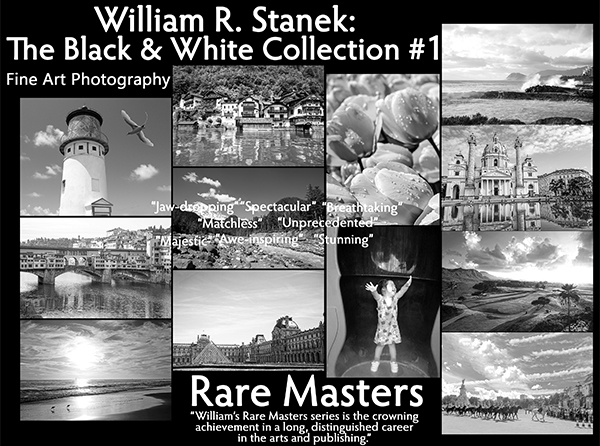
Step into a world of timeless beauty with our premium, oversized hardcover book - crafted for discerning collectors and anyone who values the power of art. Perfect for your coffee table, it's more than just a book; it's a conversation starter, a window into over 30 years of William's visionary photography.
Your Support Matters
Purchasing artwork from William Stanek's collection not only brings beauty into your life but also helps us continue to share. Thank you for supporting our creative journey!

Support The Lights of Paris by Robert Stanek, William Stanek's pen name! Through vivid historical detail and deeply moving character stories, Robert takes readers on an unforgettable journey through one of history’s most transformative times.


